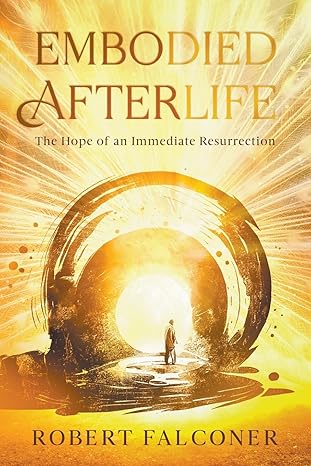What happens to believers when they die? Will we become disembodied souls, floating around heaven for all eternity? Will we wait with Jesus in an intermediate state until his second coming? Or will we, perhaps, experience an immediate resurrection? In this surprisingly accessible book, Embodied Afterlife, Dr Robert Falconer argues that the last option is the most theologically and biblically sound option.
Immediate Resurrection or Intermediate State?
One of the most commonly held conceptions of what happens to a believer straight after they die—before Jesus’ return—is that they exist in a disembodied state, in ‘paradise’ or ‘heaven’, with Jesus. This is commonly called the ‘intermediate state’. At Jesus’ second coming, so the thinking goes, they will be reunited with their resurrected bodies in the new heavens and new earth. This is described, for example, in the Westminster Confession of Faith.
The intermediate state assumes a person can exist meaningfully and completely as a spirit without their body.
But Falconer spies a theological problem with the intermediate state: it assumes a person can exist meaningfully and completely as a soul and/or spirit, without their body. Why then, he asks, do we need a resurrected body (p50-52)? This body-soul dualism undermines the bodily resurrection of Christ and bodily resurrection of believers, which Paul clearly expresses in 1 Corinthians 15 (p57-58). Falconer later spends a chapter delving into various understandings of the body-soul distinction and how those interact with the different views of the afterlife and resurrection (see chapter 6).
To make his case, Falconer considers several New Testament passages on the resurrection. In each, he asks whether they support the intermediate state or an immediate resurrection. These include: the parable of Lazarus and the rich man (Luke 16:19-31); the thief on the cross (Luke 23:39-43); Jesus bringing Lazarus back from the dead (John 11:1-44); Jesus’ words “I go to prepare a place for you” (John 14:2-4); Jesus’ triumph over death (Ephesians 4:8b-10; 1 Peter 3:18-22; Revelation 1:18); and the resurrected persons in Matthew 27:51-53. His most compelling arguments, in my view, come from 1 Corinthians 15; 1 Thessalonians 4:13-18; and Revelation 20:4-6, 12-15.
Falconer concludes that it’s unlikely these passages support an intermediate state or disembodied existence after death (p95-119, 158). There is more biblical support for the immediate resurrection, he argues, and “while an immediate embodied resurrection is not explicit in the Bible, it is a good and reasonable option” (p114).

Embodied Afterlife: The Hope of an Immediate Resurrection
Robert Falconer
Embodied Afterlife: The Hope of an Immediate Resurrection
Robert Falconer
For many Christians, one of the most important aspects of their faith is the sure and certain knowledge that they will be reborn after death, resurrected to live on forever, free from suffering and pain. Most of us imagine that this is a distant future event. We have conflicting information about heaven being an eternal disembodied spiritual state or a temporal disembodied state, where one waits for the general resurrection. But what if there was an alternative?
However, this suggestion also relies on a particular view of time, that it’s experienced differently in the afterlife.
The Philosophical Case: Time in the Afterlife
The biblical and theological grounds (above) are supported by a philosophical-theological reflection on God and time. Here, Falconer follows in the footsteps of James T. Turner Jr’s Resurrection of the Dead and T. F. Torrance’s Space, Time and Resurrection.
Falconer makes the convincing argument, using various fields of physics, that we know “the passing of time is not consistent throughout the world, let alone the universe” (p175). Furthermore, God must experience time differently to how we do (Psalm 90:4). God can even manipulate time (Joshua 10:8-14; Habakkuk 3:11; Isaiah 38:4-8) (p176-178). This means that we can be open to the possibility that our experience of time in the afterlife will be different to how we experience it now.
Perhaps a person who dies experiences no time between their death and their bodily resurrection at Christ’s return.
Perhaps a person who dies experiences no time between their death and their bodily resurrection at Christ’s return. This is called ‘truncated time’ and is much like the feeling of waking up after general anaesthetic. This would mean experiencing the resurrection as an immediate event, upon death. For “we are immediately taken into his presence in resurrected life and participate in him” (p185-186). Falconer quotes T. F. Torrance here in support of this view. “Looked at from the perspective of the new creation, there is no gap between the death of the believer and the parousia of Christ, but looked at from the perspective of time that decays and crumbles away, there is a lapse in time between them.”
Falconer adds that this view of time “does not prove an immediate resurrection but supplies the possibility of it” (p187). While he is clear that we cannot be certain this is what believers will experience, these philosophical grounds certainly reinforce the biblical and theological case which he makes for the immediate resurrection.
Appraisal and Two Criticisms
Falconer writes accessibly, with warmth and humility—I really appreciated that he humbly notes at least one unresolved aspect in his argument (p142). He certainly has a gift for making complex concepts not only understandable but also applicable.
Falconer has provided a wonderful overview of the resurrection.
While Falconer’s emphasis is to make an argument for the immediate resurrection, he’s also provided a wonderful overview of the resurrection. This includes a survey of theories that seek to discredit Jesus’ resurrection and the evidence for it (chapter 1); short discussions on what happens to foetuses, infants, little children, and people with serious mental disabilities when they die; as well as a consideration of purgatory and hell (chapter 3). The topic of near-death experiences is even used as a tool to suggest that there are both spiritual and physical features in the afterlife, along with a different experience of time (chapter 5).
The above strength is, however, one of the weaknesses of this book; Falconer attempts to cover too many topics. However his simplicity and numerous citations means Embodied Afterlife can function as an introduction to the many discussions that revolve around the resurrection. I’ll mention one more disappointment with the book: it doesn’t include many African writers or African ideas about what happens to a person after they die. I believe the immediate resurrection could be helpful in these discussions.
Reimagining Death With Hope
Falconer concludes Embodied Afterlife with a beautiful chapter titled “Resurrection Pilgrimage” (chapter 8). In it, he shows from scripture how the resurrection helps us to live differently now, in light of what is to come, even in suffering. The hope it provides for those in Christ—the bodily resurrected Christ—is a glorious and sure hope of our own—possibly immediate—bodily resurrection and life with him (Romans 6:4-5).
Christ has conquered death and we have a hope that changes how we live today.
Even if you don’t finish the book feeling completely convinced of the immediate resurrection, I have no doubt that you will feel incredibly hopeful. Christ has indeed conquered death, and we have a hope that changes how we live today.









